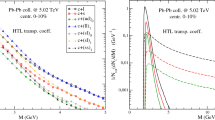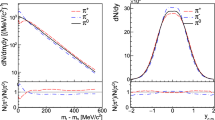Abstract
Strong chromofields generated at early stages of ultrarelativistic nuclear collisions may explain not only creation of the quark-gluon plasma but also collective deceleration of net baryons. This is demonstrated by solving classical equations of motion for baryonic slabs under the action of a time-dependent chromofield. We have studied sensitivity of the slab trajectories and their final rapidities to the initial strength and decay time of the chromofield, as well as to the back reaction of the produced plasma. By proper choice of the initial chromofield energy density we can reproduce significant baryon stopping, an average rapidity loss of about two units, observed for Au + Au collisions at RHIC. Using a Bjorken-like hydrodynamical model with the particle production source, we also study the evolution of partonic plasma produced as the result of the chromofield decay. Due to the delayed formation and expansion of plasma its maximum energy density is significantly lower than the initial energy density of the chromofield. It is shown that the fluctuations of the chromofield due to the stochastic distribution of color charges help to populate the midrapidity region in the net-baryon distribution. To fit the midrapidity data we need the chromofields with initial energy densities in the range of 30 to 60 GeV/fm3. Predictions of baryon stopping for Pb + Pb collisions at LHC energies are made.
Similar content being viewed by others
References
I. N. Mishustin and K. A. Lyakhov, Phys. Rev. C 76, 011603(R) (2007).
A. Casher, H. Neuberger, and S. Nussinov, Phys.Rev. D 20, 179 (1979); N. K. Glendenning and T. Matsui, Nucl. Phys. B 141, 419 (1984); article K. Kajantie and T. Matsui, Phys. Lett. B 164, 373 (1985); M. Gyulassy and A. Iwazaki, Phys. Lett. B 165, 157 (1985).
L. D. McLerran and R. Venugopalan, Phys. Rev. D 49, 2233, 3352 (1994); Phys. Rev.D 50, 2225 (1994); Phys. Rev. D 59, 094002 (1999); hep-ph/0202270.
L. V. Gribov, E. M. Levin, and M. G. Ryskin, Phys. Rep. 100, 1 (1983); article D. Kharzeev, E. Levin, and K. Tuchin, Phys. Rev. C 75, 044903 (2007).
J. Schwinger, Phys. Rev. 82, 664 (1951); F. Sauter, Z. Phys. 69, 742 (1931); W. Heisenberg and H. Euler, Z. Phys. 98, 714 (1936).
G. Gatoff, A. K. Kerman, and T. Matsui, Phys. Rev. D 36, 114 (1987).
K. J. Eskola and M. Gulassy, Phys. Rev. C 47 2329 (1993).
L. Wilets and R. D. Puff, Phys. Rev. C 51, 339 (1995).
A. Kovner, L. D. McLerran, and H. Weigert, Phys. Rev. D 52, 3809, 6231 (1995).
S. Jeon and R. Venugopalan, Phys. Rev.D 70, 105012 (2004).
M. Gyulassy and L. McLerran, Phys. Rev. C 56, 2219 (1997).
G. Gatoff, A. K. Kerman, and D. Vautherin, Phys. Rev. D 38, 96 (1988).
I. G. Bearden et al. (BRAHMS Collab.), Phys. Rev. Lett. 93, 102301 (2004).
S. A. Bass et al., Prog. Part. Nucl. Phys. 41, 225 (1998).
N. S. Amelin, N. Armesto, C. Pajares, and D. Souza, Eur. Phys. J. C 22, 149 (2001).
K. Itakura, Yu. V. Kovchegov, L. McLerran, and D. Teaney, Nucl. Phys. A 730, 160 (2004).
S. A. Bass et al., Phys. Rev. Lett. 91, 052302 (2003).
I. N. Mishustin and J. I. Kapusta, Phys. Rev. Lett. 88, 112501 (2002).
V. K. Magas, L. P. Csernai, and D. Strottman, Nucl. Phys. A 712, 167 (2002).
Yu. B. Ivanov, I. N. Mishustin, and L. M. Satarov, Nucl. Phys. A 433, 713 (1985).
C.-Y. Wong, Introduction to High-Energy Heavy-Ion Collisions (World Sci., Singapore, 1994), p. 249.
H. B. Nielsen and P. Olesen, Nucl. Phys. B 61, 45 (1973).
G. S. Bali, C. Schlichter, and K. Schilling, Phys. Rev. D 51, 5165 (1995).
R. W. Haymaker, V. Singh, Y. Peng, and J. Wosiek, Phys. Rev. D 53, 389 (1996).
N. Armesto, M. A. Braun, E. G. Ferreiro, and C. Pajares, Phys. Rev. Lett. 77, 3736 (1996).
S. Fortunato, F. Karsch, P. Petreczky, and H. Satz, Phys. Lett. B 502, 321 (2001).
M. A. Braun, F. del Moral, and C. Pojares, Phys. Rev. C 65, 024907 (2002).
K. Werner, Phys. Rev. Lett. 98, 152301 (2007).
L. D. Landau and I. M. Lifshits, The Field Theory (Plenum, Oxford, 1964).
P. Goddard, J. Goldstone, C. Rebbi, and C. B. Thorn, Nucl. Phys. B 56, 109 (1973).
G. Martens, C. Greiner, S. Leupold, and U. Mosel, Phys. Rev. D 70, 116010 (2004).
D. Kharzeev and M. Nardi, Phys. Lett. B 507, 121 (2001).
V. Topor Pop, M. Gyulassy, J. Barrette, et al., Phys. Rev. C 75, 014904 (2007).
R.-C. Wang and C.-Y. Wong, Phys. Rev. D 38, 348 (1988).
C. Martin and D. Vautherin, Phys. Rev. D 38, 3593 (1988).
F. Gelis, K. Kajantie, and T. Lappi, Phys. Rev. C 71, 024904 (2005).
A. A. Grib, S. G. Mamaev, and V. M. Mostepanenko, Vacuum Quantum Effects in Strong External Fields (Atomizdat, Moscow, 1988) [in Russian].
V. V. Skokov and P. Lévai, Phys. Rev. D 71, 094010 (2005).
E. Kolb and M. Turner, The Early Universe (Addison-Wesley, Redwood City, CA, 1990).
J. Bjorken, Phys. Rev. D 27, 140 (1983).
R. J. Fries, J. I. Kapusta, and Y. Li, Nucl. Phys. A 774, 861 (2006).
W. H. Press et al., Numerical Recipes in Fortran (Cambridge Univ. Press, Cambridge, 1988), p. 151.
A. Bialas, W. Czyz, A. Dyrek, and W. Florkowski, Z. Phys. C 46, 439 (1990).
B. Andersson, G. Gustafson, G. Ingelman, and T. Sjöstrand, Phys. Rep. 97, 31 (1983).
Z. Xu and C. Greiner, Phys. Rev. C 71, 064901 (2005).
J. I. Kapusta and Ch. Gale, Finite-Temperature Field Theory: Principles and Applications (Cambridge Univ. Press, Cambridge, 2006).
L. P. Csernai, Introduction to Relativistic Heavy Ion Collisions (Wiley, New York, 1994), p. 88.
M. G. Alford, K. Rajagopal, and F. Wilczek, Phys. Lett. B 422, 247 (1998).
G. Wolschin, Phys. Rev. C 69, 024906 (2004)
F. Cooper and G. Frye, Phys. Rev. D 10, 186 (1974).
D. Kharzeev and E. Levin, Phys. Lett. B 523, 79 (2001).
T. Hirano and Y. Nara, J. Phys. G 31, S1 (2005).
L. M. Satarov, A. V. Merdeev, I. M. Mishustin, and H. Stöcker, Phys. Rev. C 75, 024903 (2007); Phys. At. Nucl. 70, 1773 (2007).
Author information
Authors and Affiliations
Corresponding author
Additional information
The text was submitted by the authors in English.
Rights and permissions
About this article
Cite this article
Mishustin, I.N., Lyakhov, K.A. Baryon deceleration and partonic plasma creation by strong chromofields in ultrarelativistic heavy-ion collisions. Phys. Atom. Nuclei 75, 371–392 (2012). https://doi.org/10.1134/S1063778812030131
Received:
Accepted:
Published:
Issue Date:
DOI: https://doi.org/10.1134/S1063778812030131




